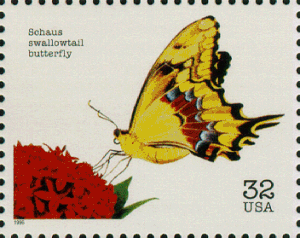Reports over the last decade point to steep, widespread declines of butterflies in Europe and North America, and increasing evidence that the problem represents an emerging global crisis. If butterflies are decreasing in abundance and/or distribution, it is likely that other groups of native insects as well as birds and mammals may be experiencing similar trends. Thus, butterflies are good surrogates of overall biodiversity patterns. In 1976 the Schaus’ Swallowtail (Heraclides aristodemus ponceanus), a large butterfly found only in the Upper Florida Keys, was among the first insects given legal protection under the federal Endangered Species Act.
Three other butterflies occurring in southern Florida, the Miami Blue (Cyclargus thomasi bethunebakeri), Bartram’s Scrub-Hairstreak (Strymon acis bartramii) and Florida Leafwing (Anaea troglodyta floridalis), are candidates for listing. Two butterflies found only in southern Florida, the Florida Zestos Skipper (Epargyreus zestos oberon) and the Rockland Meske’s Skipper (Hesperia meskei pinocayo) are now presumed to be extinct. The loss of the Florida Zestos Skipper and the Rockland Meske’s Skipper represent the first butterfly extinctions in Florida, and are among the few butterflies known to have become extinct in the United States. The Bahamian Swallowtail (Heraclides andraemon bonhotei) and Nickerbean Blue (Cyclargus ammon) have also disappeared from Florida, although they survive elsewhere in the West Indies. The Florida Leafwing, Bartram’s Scrub-hairstreak, Florida Purplewing (Eunica tatila tatilista), Keys’ populations of the Palatka Skipper (Euphyes pilatka klotsi), and others have declined to such limited geographic areas and small population sizes that they are unlikely to survive without recovery programs.
Source:
STATEMENT ON THE DECLINE AND LOSS OF BUTTERFLY SPECIES IN SOUTHERN FLORIDA
by the Imperiled Butterflies Work Group, May 1, 2011 (attached)

- Log in to post comments
